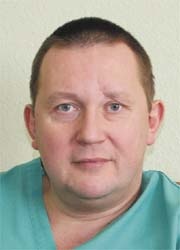Russian surgeons perform cardiac autotransplantation to treat giant left atrium, severe mitral and tricuspid regurgitation
Olga Ostrovskaya reports
Arrythmogenic remodelling of the left atrium is a common complication of atrial fibrillation, leading to severe haemodynamic disturbances.

Different methods of left atrium walls suture application are widely used as a surgical option for atriomegaly treatment and sinus rhythm recovery. These techniques may also be accomplished by Cox-Maze procedure. Unfortunately, these operations, sometimes, are not effective.
In such cases autotransplantation may be an alternative. Since 1984, a 60-year-old female had severe thyrotoxic craw and persistent atrial fibrillation. Since 2003, she experienced shortness of breath after minimal physical activity and oedema. In December 2005, the patient was admitted for treatment at the Federal Almazov Centre in Saint-Petersburg, with severe congestive heart failure NYHA class IV. Massive combined therapy decreased NYHA class to III. Echocardiograph data revealed severe mitral, tricuspid regurgitation and dilatation of the cardiac chambers: LA – 106x110 mm, LA volume – 810 ml, LVEDD – 69 mm, LVESD – 38 mm, EF – 75%, mitral valve annulus – 50 mm, tricuspid valve annulus - 48 mm. PA pressure was 68 mmHg.
In May 2006, the patient was selected for cardiac autotransplantation surgery. The bypass time was 194 minutes; cross clamp time - 164 minutes. The early postoperative period was stable and without complications.
‘This case report demonstrates modern opportunities for surgical remodelling of left atrium, complicated by valve disease. The success of this operation was achieved by all our surgical team, using anaesthesia and bypass guidelines, postoperative intensive care management and adequate surgical technique,’ said lead surgeon Mike Gordeev at the Almazov Centre. ‘After six months, this type of surgery was implemented here once again. Our team has prepared for autotransplantation for several years. In my opinion this method is more complicated than usual heart transplantation. That’s why we can now organise big heart transplantation in our centre.’
30.04.2008











